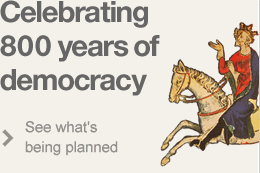Robert FitzWalter (d. 1235) has as good a claim as anyone to being regarded as the leader of the baronial opposition to John, styling himself in letters ‘Marshal of the Army of God’. An enigmatic personality, by turns shifty and querulous, conspiratorial and high principled, he played a major part in the events of 1215 and so contributed substantially to Magna Carta becoming part of the fabric of English political society.
Robert was born around 1180, the son of Walter FitzRobert, lord of Dunmow (Essex) and Baynard’s Castle, London, and Matilda, daughter of Henry II’s justiciar, Richard de Lucy. Robert’s grandfather, another Robert, the king’s steward, was a younger son of Richard fitzGilbert de Clare, a relationship which meant that Robert himself had ties of cousinage with greatest baronial family in Essex and Suffolk and another family implicated in the rebellion of 1215. When he succeeded his father in 1198, Robert inherited a barony of over 66 knights’ fees, to which he could add another 32 fees brought to him by his wife Gunnora, daughter and heiress of Robert de Valognes. The combined barony made him, in the words of the Histoire des Ducs de Normandie ‘one of the greatest men in England and one of the most powerful’.
The most controversial episode of Robert’s early life was one in which he was involved with Saer de Quincy, later earl of Winchester, and a fellow member of the Twenty Five. The pair had been entrusted with the command of the castle of Vaudreuil in the Seine valley, a key point in the defence of Normandy against the French. In 1203, however, they surrendered the stronghold to King Philip and his forces without striking a blow, provoking accusations of cowardice and even of collusion with the enemy. The episode is a mysterious one, and it is not at all clear what lay behind the two men’s move. On 5 July the pair obtained letters from the king saying that the castle had been surrendered at his command and that the castellans and garrison were to be unmolested. Robert and Saer were to remain close allies. Robert’s later use of the Quincy arms on his heraldic seal indicates that the two had become brothers-in-arms, a chivalric relationship signifying mutual assistance and protection in the field and the sharing of any of the profits of war afterwards.
Robert’s relations with John came to a crisis in 1212. Again, what lies behind the sequence of events is obscure, and we have only the uncertain testimony of the chroniclers to guide us. According to the St Albans and Dunstable writers, as John was mustering an army at Chester for an expedition against the Welsh, word reached him of a plot on his life, causing him suddenly to abandon his plans and instead march north to crush the sources of insurrection there. Apparently the two ringleaders were Eustace de Vesci and Robert FitzWalter, both of whom then fled the realm, in the latter’s case to France. What lay behind Robert’s disaffection is not clear. The chroniclers’ explanations appear not to take us to the heart of the matter. According to Wendover at St Albans, the cause of the problem was a quarrel between FitzWalter and the abbey of St Albans over his rights in their dependent house of Binham Priory, in which he felt let down by the king. In Wendover’s account, FitzWalter alleged that, contrary to the priory’s foundation charter granted by his wife’s ancestor, the abbot of St Albans had demanded excessive hospitality, had installed too many monks and had taken far too much revenue; worse still, he reports, during FitzWalter’s absence with the king in Ireland, the abbot had installed a new prior. FitzWalter responded by laying siege to the priory, provoking the king, on the abbot’s appeal, to send troops against him. Whether or not events unfolded exactly as Roger of Wendover records, the episode hardly seems important enough to justify a plot on the king’s life. Another source, the Histoire des Ducs de Normandie offers two alternative explanations for FitzWalter’s flight. According to one of these, told apparently by the Englishman to the French king, the former was resentful that John had attempted to seduce his daughter Matilda, the wife of Geoffrey de Mandeville, while, according to another, more plausible account, he was angry that John had threatened to hang de Mandeville for killing an esquire at court, threatening ‘You’ll see 2,000 knights in your land before you hang him!’. Perhaps of greater relevance than either of these stories is the matter of his ties with the Braose family, who were bitter enemies of John. FitzWalter’s brother Walter was archdeacon of Hereford and thus an associate of Giles de Braose, bishop of Hereford, brother of William de Braose, whom John in a venomous feud had driven from the realm.
In 1213 Robert and his fellow conspirator, Eustace de Vesci, were both reconciled with the king, and restored to their lands, as part of the general settlement that John negotiated with the Church. Robert’s relations with John remained testy, however, and he did not accompany the latter on his expedition to Poitou in 1214; nor did he contribute to the scutage levied to defray the costs of the expedition. Wendover tells us that he was present at the celebrated meeting at Bury St Edmunds in November 1214, at which the barons swore to compel the king to confirm the coronation charter of Henry I. By early 1215 the signs are that he was moving to the forefront of the baronial leadership. In January he was one of those at the barons’ meeting with the king at which John pledged to answer their grievances at Easter. By the end of April, after John had refused satisfaction, he took up arms with the other eastern lords and somewhere between Stamford and Northampton linked up with the Northerners, who were making their own way south. On 5 May, probably at Brackley, the rebels formally defied John, renouncing their oaths of homage, and chose Robert FitzWalter as their leader. After the fall of London Robert was involved in strengthening the city’s defences, demolishing the houses of the Jews for building material. At Runnymede after the making of the Great Charter he was appointed to the committee of Twenty Five. On 19 June he was named first among the barons with whom John made a treaty laying down that unless he violated the Charter, London would be yielded to him by15 August.
FitzWalter’s main priority in the war that followed King John’s rejection of Magna Carta in the autumn was to ensure the retention of baronial control of London. In October, to prevent an assault by the king’s mercenary force on London, he and his allies seized Rochester Castle, placing William d’Albini in charge of its defence. As soon as the king laid siege to the castle, however, and in the process destroyed the bridge over the Medway, FitzWalter was forced to withdraw, judging that he would be the loser in any confrontation with the royalists. Early the next year, with the king regaining the military initiative, FitzWalter and his comrade-in-arms Saer de Quincy travelled to France to seek the help of the French king’s son, Louis, to whom they offered the crown. Louis landed at Pegwell Bay on 21 May, and on 3 June, the day after his arrival in London, FitzWalter and the mayor, William Hardel, led the barons and citizens in performing homage to him.
FitzWalter remained firmly in the rebel camp in the wake of John’s death in October 1216, and in April 1217 led the relief of the earl of Chester’s siege of de Quincy’s castle at Mountsorrel (Leics.). Once the earl had withdrawn his men, he and his French allies turned east to Lincoln to assist in their siege of Lincoln Castle, which was being held for the king. On 19 May, however, a royalist relieving force under the Marshal arrived, and there was a difference of opinion in the baronial camp over how to respond. FitzWalter is reported to have advised an attacking strategy, but he was overruled, and the barons, playing for safety, withdrew into the walled city. The decision turned out to be a fatal misjudgement. The royalists found a way in, routed their opponents, and virtually the whole of the baronial leadership were taken prisoner. FitzWalter regained his freedom under the terms of the general settlement negotiated at Kingston in September, and he was at large again by the following month. He attended a great council held at Westminster at the end of October at which the former rebels performed homage and fealty to the king. In 1219 he and his old partner Saer embarked on the Fifth Crusade and took part in the siege of the Egyptian city of Damietta. After his return to England he actively involved himself in the politics of the Minority, evidently reconciled to the court, and witnessed the final and definitive reissue of the Charter on 11 February 1225. He died on 9 December 1235 and was buried in Dunmow Priory. His elder son Robert, who had fought with him at Lincoln, had predeceased him, and his heir was a minor, Walter, the son of his second marriage to Rohese.
FitzWalter can easily come across as an unsympathetic figure – at once haughty and petulant, unsubtle and apparently motivated more by personal grievance than concern for the common good. Like others among the Twenty Five, he used a political quarrel as a vehicle for the pursuit of family claims. Much of his time was spent in trying to recover Hertford Castle, to which he had a tenuous claim through his wife. At the same time, however, he was resolute in his opposition to John, and his involvement in the crusade and support for the Minority government belie his image as a turbulent malcontent. Matthew Paris, the St Albans chronicler, no admirer of his, penned a generous obituary on his death. FitzWalter, he said, could ‘match any earl in England: valiant in arms, spirited and illustrious … generous, surrounded by a multitude of powerful blood relatives and strengthened by numerous relatives in marriage’. Matthew’s tribute reminds us just how important blood ties were in bringing together and sustaining the opposition of 1215. Yet the many enigmas that surround Robert equally highlight the sheer difficulty of determining baronial motivation from a distance of eight hundred years.
By Professor Nigel Saul, Royal Holloway, University of London.
Featured Article
The early settlers in the United States took with them copies of the Magna Carta. One undertaking given by King John in that Charter was as follows: No freeman shall be arrested or imprisoned or disseised or outlawed or exiled or in...
Read on...Recent Articles
- Magna Carta's American Adventure
- 800th anniversary of Bristol...
- Bristol 800 concert and...
- Emancipation and Magna Carta
- Terrorism and Tolerance -...
- Magna Carta
- Magna Carta Benches mark...
- ABA Magna Carta Memorial...
Stay updated
If you would like to keep informed about the work of the Magna Carta Trust and our partners, please sign up to the newsletter below.
Become a Supporter
There are a number of significant supporter opportunities. Register your interest early to ensure the widest range of options.
Find out more




